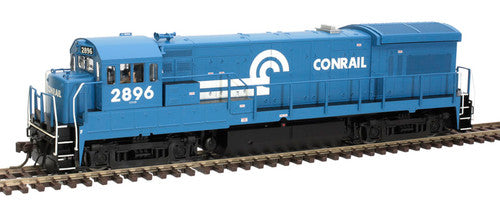The Atlas 10003798 U33B CR, a Conrail #2932 Gold model in HO scale, comes with DCC and sound features. Note that the picture might show a different road number. In the late 1960s, the horsepower race was intense. GE introduced the 3,300hp, four - axle U33B locomotive, with 137 units produced from September 1967 to August 1970. In 1970, GE upped the ante with the 3,600hp U36B, produced from May 1970 to December 1974. Externally identical, both were powered by the same GE FDL - 16 cylinder four - stroke engine, with the horsepower increase achieved through internal adjustments. A key feature is the built - out radiator “wings” on the long hood. Atlas offers both early and late phase U33B and U36B models. The early phase has flush - mounted radiator and air intake screens on the long hood and a built - out area on the top of the front and rear pilots. The late phase has corrugated screens and a flat pilot face. An optional electrical equipment box is included on the left side walkway behind the cab as per the prototype, and AAR - B or Blomberg trucks are used when appropriate. The Seaboard Coast Line 1776, built in June 1971, was the nation's first Bicentennial unit. It started the trend of railroads repainting units for the 1976 celebration. Features include a newly upgraded cab, separately - applied scale detail parts like windshield wipers and metal grab irons, a five - pole skewed armature motor with dual flywheels, directional lighting with golden - white LEDs, and blackened metal wheels. For DCC operation, it supports all programming modes, has flexible function key mapping, and six function outputs, following NMRA standards. The LokSound Select Dual - Mode decoder allows use on both DC and DCC layouts. There are over 20 sound effects, 16 user - selectable horns, 2 user - selectable bells, and 2 user - selectable synchronized brake squeals, with manual and automatic notching modes for realism.

Using your Atlas HO scale U33B CR locomotive is easy. If you're using a DCC layout, just connect the locomotive and use your DCC controller to operate it. You can program the function keys to your liking and enjoy the sound effects. For DC operation, the LokSound Select Dual - Mode decoder makes it possible, but remember that the Atlas Quantum Engineer won't work on an analog (DC) layout for this locomotive. When it comes to consist operation, on a DC - powered layout, only locomotives with both DCC and sound can be grouped together. For maintenance, keep the locomotive clean. You can use a soft brush to remove dust from the body and wheels. Check the electrical connections regularly to ensure proper function. If you notice any issues with the sound or movement, make sure to double - check the decoder settings. Store the locomotive in a dry place to prevent any damage from moisture.









